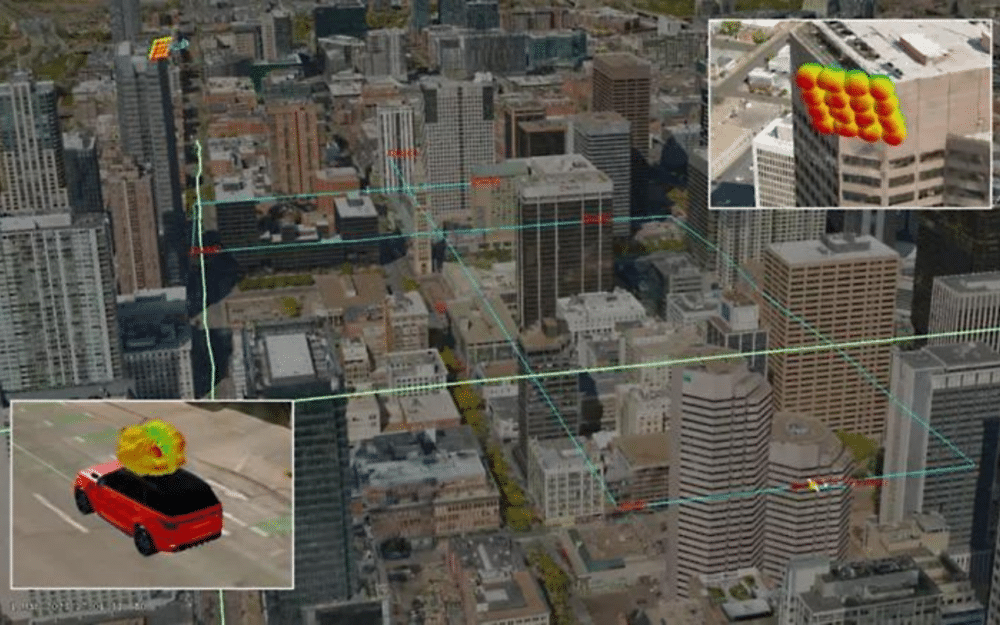We’re accustomed to physically simulating products, factories, and buildings. When ensuring a bridge or building won’t collapse, we simulate it before construction. But simulation is also becoming increasingly crucial for anticipating the complex challenges posed by smart cities, especially the implementation of wireless networks. Ansys has recently introduced an innovative solution to address these challenges. DirectIndustry talked with Christophe Bianchi, CTO at Ansys, to explore how operators can optimize their networks to meet the needs of the connected and smart city of tomorrow.
With the deployment of 5G and the promise of 6G, the ability to exchange data across wireless networks becomes essential to power the smart cities of the future.
The goal is to improve service offerings for users, which is critically important for telecommunications industry players. Indeed, monetizing 5G is now a major topic.
Traditionally, the focus has been on developing equipment for antennas and communication systems. However, with the transition to denser 5G networks, traditional analytical and statistical planning methods have become inadequate. Electromagnetic simulation becomes necessary. It accurately predicts network performance to optimize deployment strategies.
Ansys, a specialist in numerical simulation, has developed a new tool, Ansys RF Channel Modular. This tool enables real-time simulation of complex urban environments, considering factors such as signal reflection and material properties, to ensure efficient deployment of 5G and later 6G networks.
We spoke with Christophe Bianchi, CTO at Ansys.
Why is the numerical simulation of electromagnetic waves necessary today to plan 5G and soon 6G networks?
Christophe Bianchi: “The transition to 5G, which focuses mainly on urban areas, has made traditional planning methods based on statistical or parametric analyses obsolete. Indeed, the higher frequencies of 5G, particularly in the millimeter wave band beyond 23 gigahertz, pose unique challenges in terms of signal propagation in complex urban environments. Millimeter waves used by 5G can indeed be reflected in different directions. So, it has become imperative to use simulation to precisely determine the number of antennas needed to provide optimal service quality in a city.
Simulation allows us to create detailed virtual models of the urban environment and anticipate various usage scenarios, including future developments such as new urban developments. This enables informed decisions regarding the physical and software deployment of communication infrastructures for the successful implementation of 5G in an urban environment.”
You have developed a new solution that addresses this issue. Can you tell us more about it?
Christophe Bianchi: “What we have developed and presented at the Mobile World Congress a few weeks ago represents a significant evolution of our tools. We have integrated our electromagnetic simulation capabilities – our flagship technology HFSSTM – with a complete system modeling technology. This integration allows us to represent scenarios at the scale of an entire city.
The complexity of this task lies in the diversity of the scales involved. While we focus on the electromagnetic rays emitted by antennas at the nanoscale, we also need to consider the kilometer scale of the cities themselves. Our new tool allows us to simulate this full range of scales with extreme precision, and in real-time. Thus, on a computer, it is possible to visualize a city in 3D with a resolution of about five centimeters, taking into account the specific properties of construction materials, such as glass and concrete, which influence wave propagation.
This new tool, called Ansys RF Channel Modeler, offers a comprehensive solution for planning and optimizing communication networks. Whether for the deployment of new networks or the improvement of existing infrastructure, our technology allows for the effective analysis and adaptation of 5G deployments, paving the way for more efficient and reliable connectivity in urban environments and beyond.”
So, you are creating a digital twin of the city. How does it work?
Christophe Bianchi: “There are very precise physical databases available for virtually every city. Some of these databases have resolutions of up to five centimeters. This is much more accurate than what is found in a typical GPS. So we download this representation, and the person responsible for the analysis then implements the antennas in the digital twin.
Then, we define a mission in our system called digital mission engineering. This mission may involve for example drones, in the case of experiments with express delivery of medicines. How to ensure that the drone always has the necessary information to move and that the guiding signal is not obstructed by obstacles? We can simulate these scenarios.
Our tool is simple and provides various KPIs depending on the usage: latency rate, signal quality, message delivery guarantee, message prioritization, noise rate, etc. Since it is a digital twin, we can verify that the choice of new equipment is always in line with the initially set KPIs.”
Who is this solution primarily intended for? Telecom operators?
Christophe Bianchi: “In the long term, indeed, it may concern operators.
For example, when a public 5G network is deployed, several operators may be involved. What about interference? If each of these operators has deployed its own 5G network at millimeter-wave frequencies of 28 GHz, what happens? It is extremely difficult to measure all possible scenarios. How, then, can we ensure that when installing or modifying an antenna, changing providers, or migrating to another operator with its software, the service offered remains the same? The only solution is to simulate it. That’s where our tools come in.
By knowing the location and characteristics of installed antennas, we can send typical information flows to observe how these elements interact and determine whether they disrupt communication and signal quality. The more the signal is disrupted, the higher the latency and the lower the quality of service. However, ultimately, the monetization of 5G depends on the guarantee of quality of service.
Having a deep understanding of the installation and its performance allows us to make dynamic adjustments. In the context of 5G, we can allocate network slices, and prioritize certain operators, which is extremely crucial. If we envision a connected city where all vehicles are autonomous and all city infrastructures are connected by IoT to a network, and we manage traffic lights, priorities, tolls, it is important to be able to manage priority interventions, such as an ambulance or a fire truck, which must cross the city with priority.
This also applies to communication signals. Some signals may have a higher priority than others. But how can we ensure that an operator, when offering this prioritization service, can deliver it? Because selling a priority over others, and therefore charging a subscription ten times more expensive, requires a guarantee. Simulation is a tool that allows them to do this.
However, 5G is not exclusively a public service. Private 5G is booming, especially in Industry 4.0, where it is used to ensure low latency and permanent connectivity. Thus, this is a use case that could also be applied to a private network.”
What are the practical applications of this technology?
Christophe Bianchi: “One practical application of this technology lies in the realm of autonomous vehicles. To achieve level four of autonomous driving, where vehicles drive entirely on their own, vehicles must communicate with each other and with the road infrastructure, known as V2X.
The key technology to enable this is 5G. But the main question is: how to ensure that critical information is provided at the right time to make safe decisions? It is essential, for example, to ensure that bandwidth is prioritized for vital information that influences the safety of drivers and others on the road. Simulation is essential because it is impossible to test all possible safety cases on the road in a real environment.
With our advanced simulation tool, we can reproduce various scenarios with striking realism, taking into account interferences, signal quality, and service performance. This allows us to study use cases that fully exploit the potential of millimeter-wave 5G.”
Ansys’s new solution is already commercially available.











